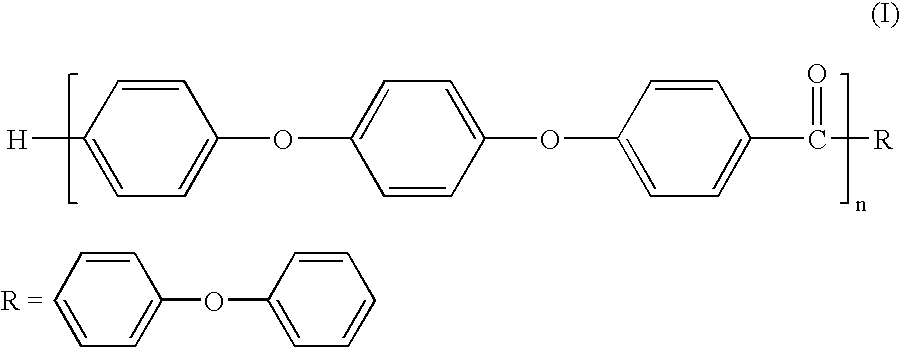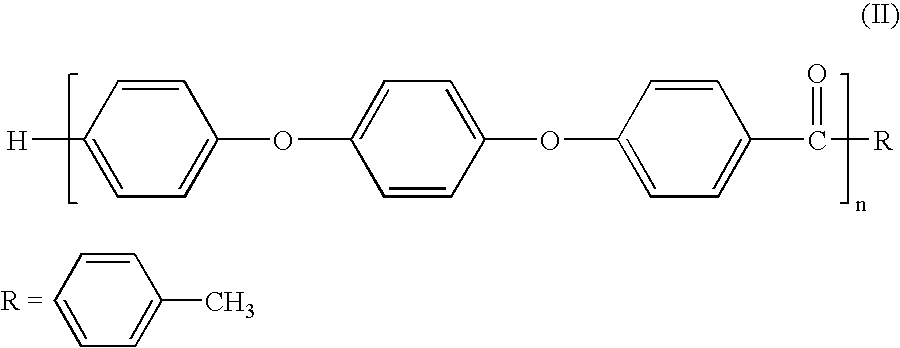Melt processible polyether ether ketone polymer
a technology of ether ketone and polyether, which is applied in the direction of chemical recycling, etc., can solve the problem that the preparation process is not only novel
- Summary
- Abstract
- Description
- Claims
- Application Information
AI Technical Summary
Benefits of technology
Problems solved by technology
Method used
Image
Examples
example 1
[0034]Thionyl Chloride (238 g, 2.0 m) was charged into a clean, 4 neck, 1 liter glass flask equipped with a magnetic stirrer, a reflux condenser with chilled water circulation, scrubbing arrangement for off-gases, a thermowell, and a dropping funnel. Thionyl Chloride was heated to 50° C., and Methane Sulphonic acid, (96 g, 1 m), was gradually charged into it over a period of 1 h. The solution was then heated to 70° C. over a period of 2.5-3 h and subsequently to 75-80° C. over a period of additional 7 h. Thereafter, the solution-was maintained at 80° C. for 3 h. During the course of heating, the off-gases which were evolved were scrubbed in an alkali scrubber. After evolution of the off-gases had ceased, the reflux condenser was removed and system modified for downward distillation. Excess Thionyl Chloride was first distilled off at atmospheric pressure, up to 120° C., then the temperature was raised to 140° C., pressure reduced to 10 mm Hg, and an intermediate cut of volatile by-pr...
example 2
[0038]The procedure of example 1 was reproduced exactly on a larger scale wherein 317 kg MSA was charged in a 2500 l glass lined reactor, heated to 60 ° C. and 99 kg of condensing agent MSAN was added to it. The solution was maintained at 60° C. and 87 kg of PPBA was added to it. The solution was maintained at 60±1° C. for 10.5 h and samples were withdrawn periodically to monitor the solution viscosity. Polymerisation reaction was terminated when the desired solution viscosity, corresponding to an Inherent Viscosity of 0.88 dl / g (of a 0.2% solution in conc. H2SO4 at 25° C.) was attained. Termination was accomplished by addition of 48 kg Diphenyl Ether and 212 kg of MSA. The endcapping reaction was allowed to continue for 10 h, at 60° C. exactly as in Example 1. The reaction mass was then precipitated in 1900 l water to extract off the acid from the polymer.
[0039]The precipitated polymer was then repeatedly extracted with water and DMAc exactly as in Example 1, and then dried. The po...
example 3
[0041]Polymerisation procedure was repeated exactly as described in Example 2, except that the reaction was terminated by the addition of suitable amounts of Diphenyl Ether and Methane Sulfonic Acid at reduced solution viscosity to give Inh. Viscosity of 0.79 dl / g. Subsequent water and DMAc treatments were completed as in Example 1 above, and the polymer powder was extruded in a laboratory extruder. The pellets so obtained were characterised for the thermal and melt flow behaviour. The polymer exhibited a Tg of 148.2° C., Tc of 181.9° C. and Tm 345.5° C. The, melt flow values were 29 cc / 10 min (at 400° C., 2.16 kg, for 6 min hold time) and 23 cc / 10 min (at 400° C., 2.16 kg for 60 min hold time), indicating excellent thermal stability. The extrudates from the melt flow apparatus at both 6 and 60 min had a glossy appearance. Thus, the thermal and rheological characteristics clearly indicated that the product obtained had linear structure with negligible or no branching, which would ha...
PUM
| Property | Measurement | Unit |
|---|---|---|
| Time | aaaaa | aaaaa |
| Time | aaaaa | aaaaa |
| Dimensionless property | aaaaa | aaaaa |
Abstract
Description
Claims
Application Information
 Login to View More
Login to View More - R&D
- Intellectual Property
- Life Sciences
- Materials
- Tech Scout
- Unparalleled Data Quality
- Higher Quality Content
- 60% Fewer Hallucinations
Browse by: Latest US Patents, China's latest patents, Technical Efficacy Thesaurus, Application Domain, Technology Topic, Popular Technical Reports.
© 2025 PatSnap. All rights reserved.Legal|Privacy policy|Modern Slavery Act Transparency Statement|Sitemap|About US| Contact US: help@patsnap.com



